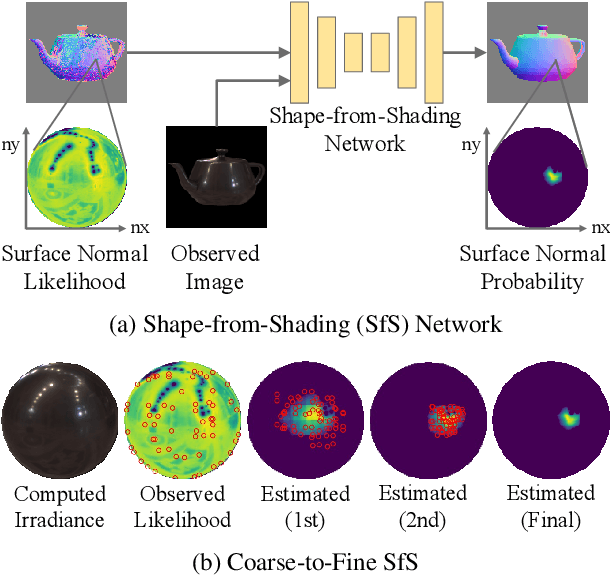Yuto Enyo
Diffusion Reflectance Map: Single-Image Stochastic Inverse Rendering of Illumination and Reflectance
Dec 07, 2023Abstract:Reflectance bounds the frequency spectrum of illumination in the object appearance. In this paper, we introduce the first stochastic inverse rendering method, which recovers the full frequency spectrum of an illumination jointly with the object reflectance from a single image. Our key idea is to solve this blind inverse problem in the reflectance map, an appearance representation invariant to the underlying geometry, by learning to reverse the image formation with a novel diffusion model which we refer to as the Diffusion Reflectance Map Network (DRMNet). Given an observed reflectance map converted and completed from the single input image, DRMNet generates a reflectance map corresponding to a perfect mirror sphere while jointly estimating the reflectance. The forward process can be understood as gradually filtering a natural illumination with lower and lower frequency reflectance and additive Gaussian noise. DRMNet learns to invert this process with two subnetworks, IllNet and RefNet, which work in concert towards this joint estimation. The network is trained on an extensive synthetic dataset and is demonstrated to generalize to real images, showing state-of-the-art accuracy on established datasets.
nLMVS-Net: Deep Non-Lambertian Multi-View Stereo
Jul 25, 2022



Abstract:We introduce a novel multi-view stereo (MVS) method that can simultaneously recover not just per-pixel depth but also surface normals, together with the reflectance of textureless, complex non-Lambertian surfaces captured under known but natural illumination. Our key idea is to formulate MVS as an end-to-end learnable network, which we refer to as nLMVS-Net, that seamlessly integrates radiometric cues to leverage surface normals as view-independent surface features for learned cost volume construction and filtering. It first estimates surface normals as pixel-wise probability densities for each view with a novel shape-from-shading network. These per-pixel surface normal densities and the input multi-view images are then input to a novel cost volume filtering network that learns to recover per-pixel depth and surface normal. The reflectance is also explicitly estimated by alternating with geometry reconstruction. Extensive quantitative evaluations on newly established synthetic and real-world datasets show that nLMVS-Net can robustly and accurately recover the shape and reflectance of complex objects in natural settings.
 Add to Chrome
Add to Chrome Add to Firefox
Add to Firefox Add to Edge
Add to Edge